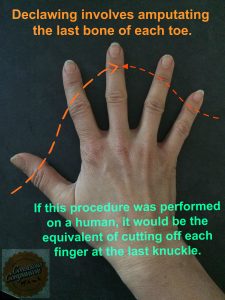***** Coastal Cat Clinic does *NOT* advise that you declaw your cat. In fact, we stand with the AAFP (American Association of Feline Practitioners) in strongly discouraging the declawing of cats. AAFP Position Statement (for declawing) ****
What, exactly, does it mean to declaw a cat?

Declawing is NOT just a short nail trim as many people still seem to think. It is a very painful surgery which involves amputating each of the cat’s toes at the last knuckle joint. A laser declaw simply is doing exactly the same surgery as any other declaw. But we use a CO2 laser scalpel to more precisely remove the last bone of the toe instead of a normal stainless steel scalpel or a sterilized nail trimmer (guillotine method).
Because we use a laser to remove the toes, we do *not* need to use tourniquets and pressure wraps to control bleeding as is needed with the other methods of declaw. The laser cauterizes as it cuts, so there is less pain and tissue trauma and a lower complication rate. The last bone of the toe (P3) grows the nail. If any part of that bone is left behind, the nail can re-grow and cause chronic pain and possibly infection in the toe. There is a much smaller chance of bone being left behind accidentally with the use of a laser.
What about pain relief?
There is significantly less bleeding and pain after a laser declaw versus a regular declaw. Please notice that I said “LESS pain”, not “NO pain”. We send cats home with their owners the day after surgery, usually walking well, and bandage-free. We use strong pain shots to help to create consistent, long-lasting pain relief after the surgery. Being sure the cat is as pain-free as we can make him/her is a top priority for us. Many cats may also need take-home medicine in addition to the standard pain protocol, especially older or larger cats. If its pain is not well managed during the perioperative and healing periods, a cat may develop long-term neuropathic or central pain.
That still sounds painful! What are alternatives to a declaw?
Environmental enrichment:
We have links here to several brochures from the AAFP on the topic of declawing and behavioral issues related to normal and destructive scratching. Hopefully you will find them useful. We also hope that they are helpful in finding other ways to deal with your cat’s normal behaviors. Adding cat trees, scratching posts, food puzzles and other things to help keep your cat’s life interesting are helpful as well. Enriching your cat’s environment is likely to solve or prevent many medical and behavioral problems, not just scratching issues.
Alternatives:
These are two short brochures about alternatives to declawing and more information, well worth the read. It can’t be emphasized enough that scratching is a NORMAL feline behavior. With a little bit of effort in training as a kitten, you can direct scratching onto desirable objects. Cats NEED to scratch.
Also, these next two links are longer but very full of useful information: living with a clawed cat. And yet another comprehensive guide for people trying to understand why cats scratch and how to teach cats to scratch desired objects.
Get them to scratch where you want them to:
Most cats can be trained to use scratching posts, corrugated cardboard flats (my cats love these), or use Soft Caws nail caps. Kitty Caps are another soft claw acrylic nail cap and are stocked at Pet Smart. There is also a new product by Ceva called Feliscratch which directs scratching onto desired objects. Use of pheromones and other tools can get most cats to scratch where you want them to.
Cornell has released a video on destructive scratching. Managing destructive scratching behavior (video)
Declawing is illegal in some places? Really?
Yes, really. It is probably only a matter of time before declawing becomes illegal in the US. Denver and few cities in California have already banned declawing. Some other US states and cities and Canadian provinces have also begun the process to ban declaws as well. Cat declaws are currently banned in the European Union (including the United Kingdom), Australia, Brazil, Israel and some other countries
Declawing is a very divisive and controversial topic, both for pet owners and vets alike. And it is an elective procedure which almost never gives any health benefits to the cat. A cat with no claws may be more likely to bite, according to several studies.
Well, then why do you even do it?
Actually, we have stopped doing it. But we used to do it because North Carolina does not currently prohibit feline declaws (still true). Other methods of doing this surgery are *much* more painful and disfiguring. If we didn’t do it with our laser, someone else would do it without the laser. That is why we *did* declaw, trying to give people and their cats a better option. We also used to have really good rates of talking people out of declawing, but over the last year or so we have been significantly less successful and fewer places are offering the service anymore. So we are not going to do it anymore either. We have left this page up and active because even though we will no longer declaw, the links for alternatives and environmental enrichment are still valuable and may yet help save cat’s toes.
What are your requirements to declaw a cat?
We no longer declaw cats.
